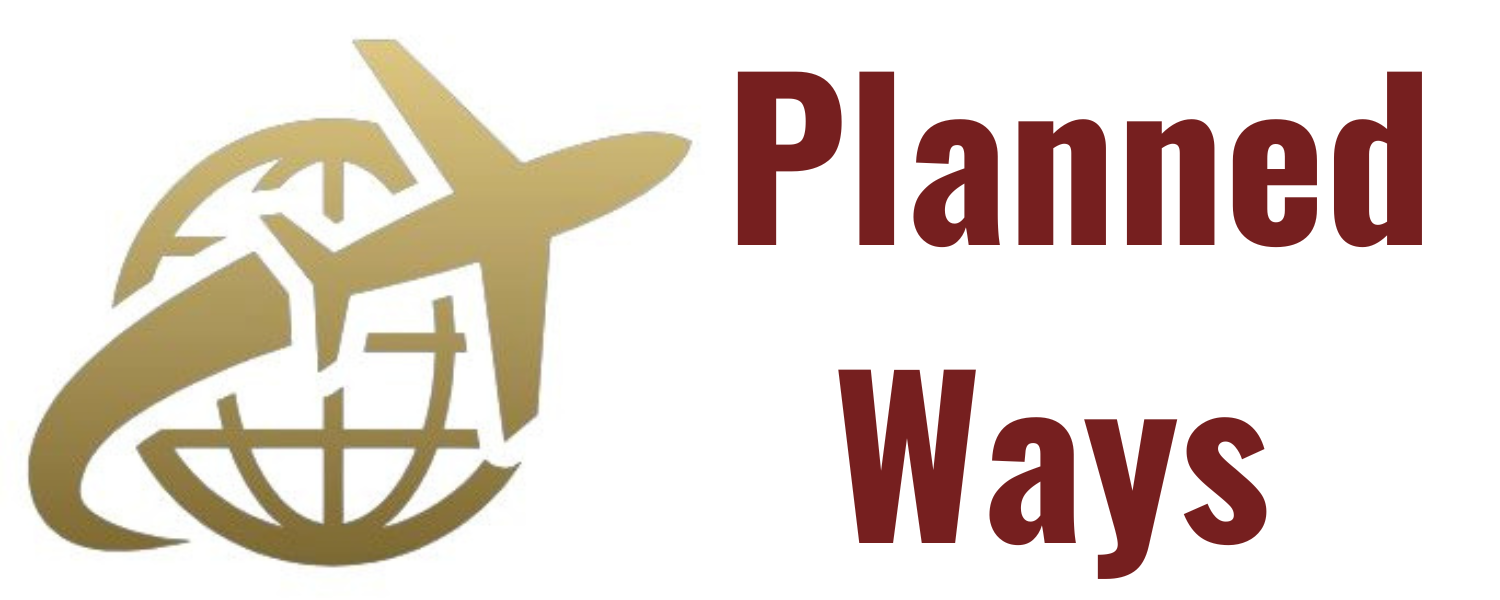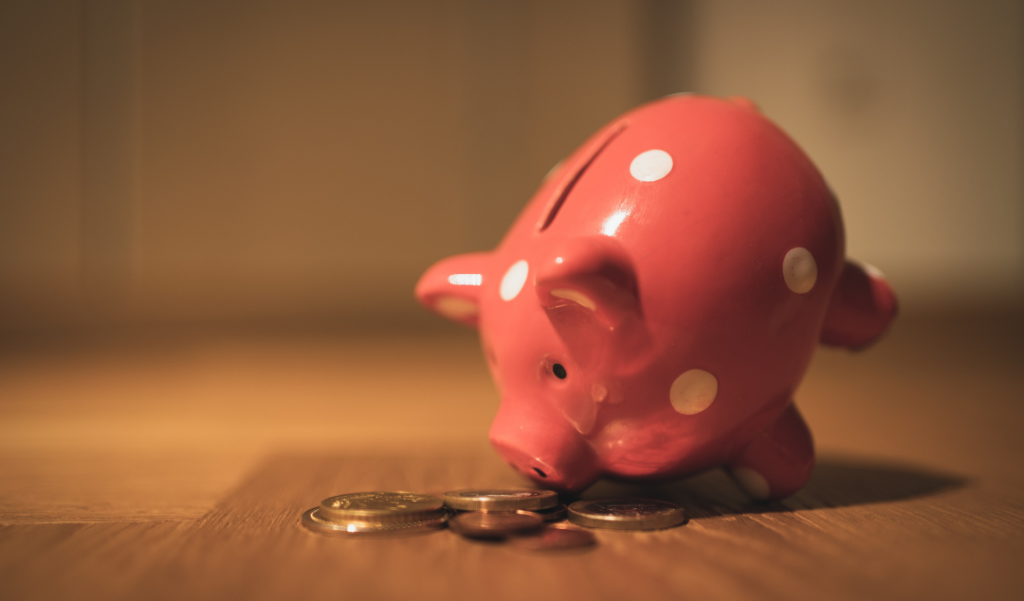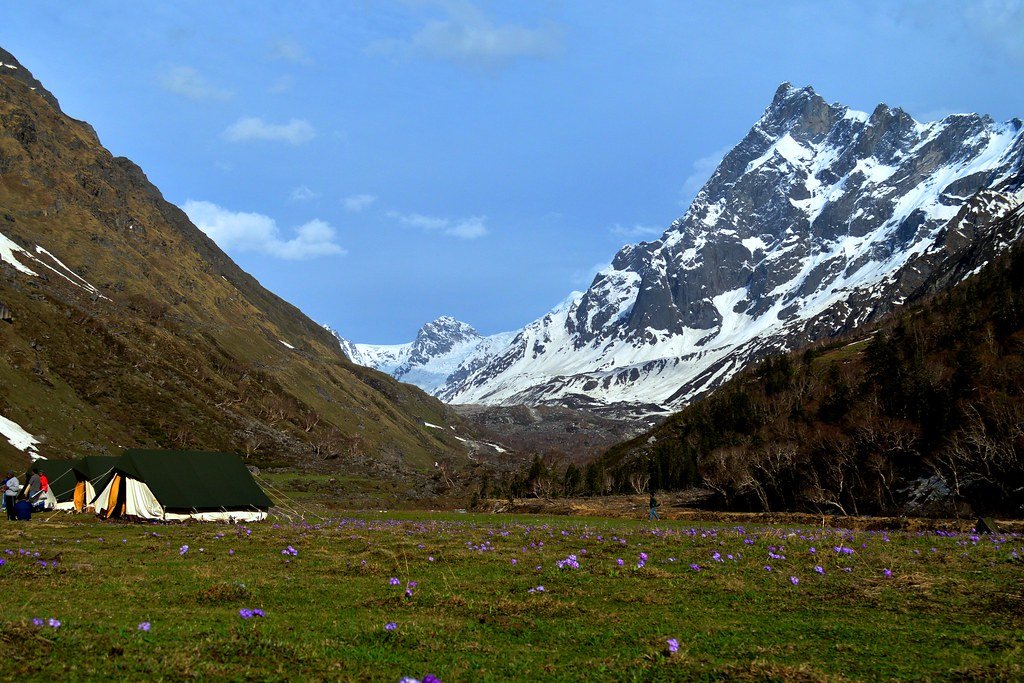Jodhpur: Discover The Blue Jewel of Rajasthan | Places To Visit In Jodhpur | How To Reach
Jodhpur, also known as the “Blue City” and the “Sun City,” is a historic city in the Indian state of Rajasthan. Jodhpur, founded in 1459 by Rao Jodha, is a historic city that served as the capital of the princely state of Jodhpur. Jodhpur remains a city of contrasts, where ancient customs and modern aspirations coexist in a delicate balance. Whether exploring the winding streets of the old city, marveling at the grandeur of Mehrangarh Fort, or simply savoring the flavors of Rajasthani cuisine, every moment in Jodhpur is a journey through time, a testament to the enduring spirit of a city that has stood the test of time.
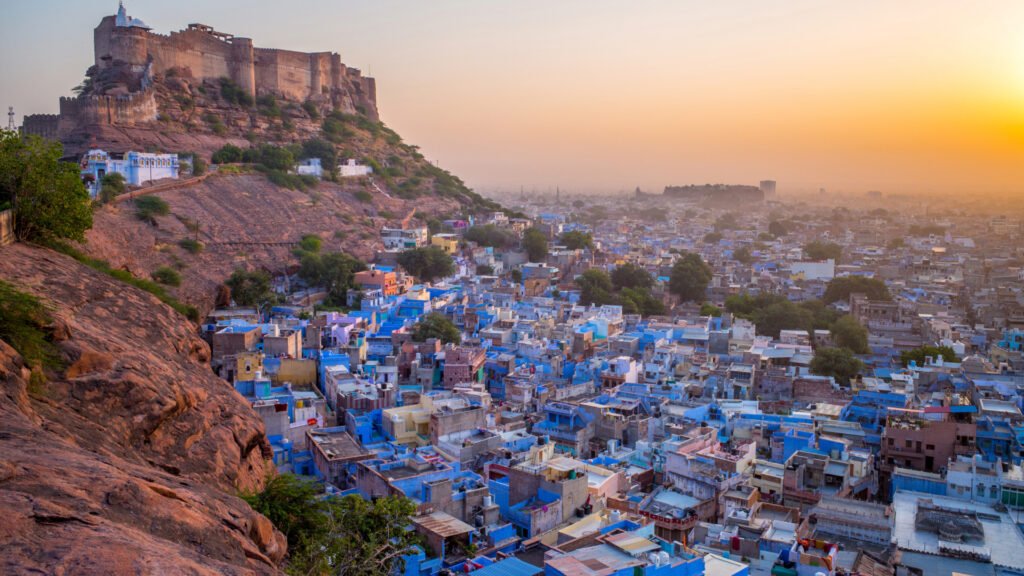
Best Places To Visit In Jodhpur:
The city’s distinctive blue-colored houses in the old quarter add to its unique charm. Jodhpur is rich in cultural heritage and is home to the splendid Umaid Bhawan Palace, a majestic architectural marvel. The bustling Sardar Market and Clock Tower, the serene Jaswant Thada, and the scenic Kaylana Lake are among the many attractions that showcase Jodhpur’s royal past and vibrant present. Known for its traditional handicrafts, textiles, and delicious local cuisine, Jodhpur offers visitors a delightful blend of history, art, and cultural experiences in the heart of Rajasthan.
Here are some places to visit in Jodhpur:
1. Mehrangarh Fort
Mehrangarh Fort is a magnificent fort in Jodhpur, Rajasthan, India. It was built by Rao Jodha, the founder of Jodhpur, in 1459 on a hill that rises 122 meters above the city. The fort is one of the largest and best-preserved forts in India, and it showcases the rich cultural and artistic heritage of Rajasthan. The fort has seven gates, several palaces, a temple, and a museum that displays various artifacts and relics of the royal past. The fort also offers a stunning view of the blue city of Jodhpur from its ramparts. Mehrangarh Fort is open daily from 9:00 am to 5:00 pm. While fort entry is free, there’s a fee for the museum, and international guests pay Rs. 600/person, including an audio guide.
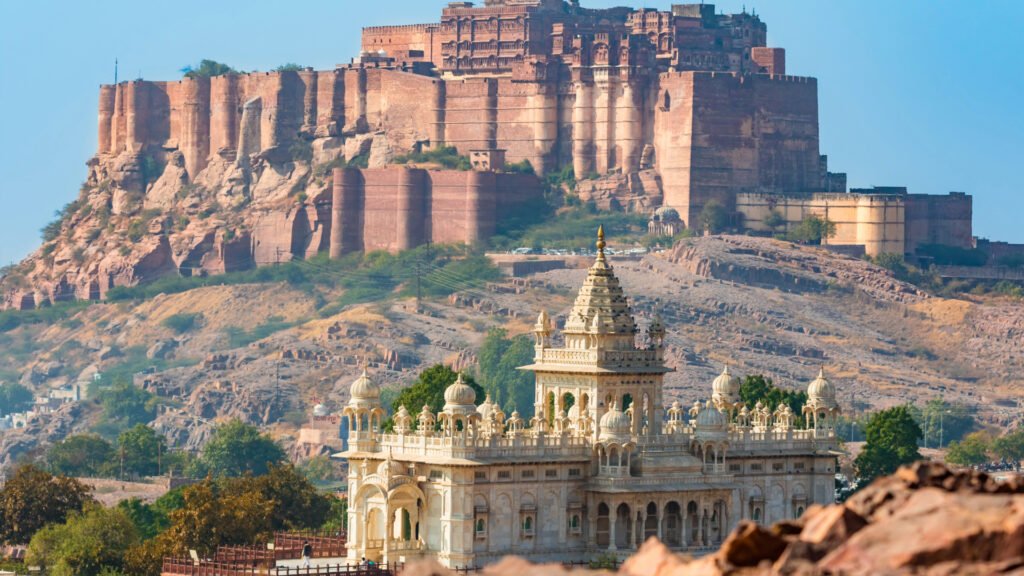
2. Jaswant Thada
Jaswant Thada is a beautiful white marble mausoleum. It was built in 1899 by Maharaja Sardar Singh in memory of his father, Maharaja Jaswant Singh II, the 33rd Rathore ruler of Jodhpur. The mausoleum is also known as the Taj Mahal of Marwar because of its resemblance to the famous monument in Agra. The mausoleum has intricate carvings, a domed ceiling, a chandelier, and a cenotaph that displays portraits of the Jodhpur rulers. The mausoleum is surrounded by a landscaped garden with a pond and sandstone sculptures. Jaswant Thada is a popular tourist attraction and a symbol of the rich culture and history of Rajasthan. Jaswant Thada welcomes visitors daily from 9:00 am to 5:00 pm. The entry fee is Rs. 30 for domestic guests and Rs. 50 for international guests, with additional charges for a still camera (Rs. 25) or a video camera (Rs. 50).
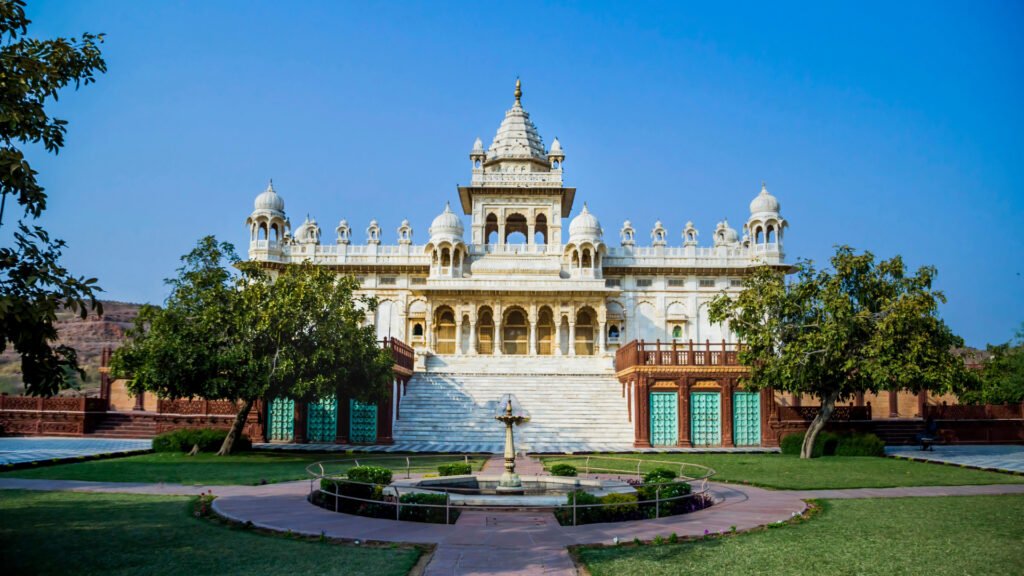
3. Balsamand Lake and Garden
Balsamand Lake and Garden is a serene and picturesque destination. Originating in the 13th century under Gurjara-Pratihara ruler Balak Rao Parihar, the man-made lake served as a water reservoir until the 18th century. Maharaja Jaswant Singh developed the lush 200-acre garden in the 19th century, showcasing exotic plants, flowers, trees, and a small zoo with peacocks, rabbits, and crocodiles. Visitors can engage in activities like boating, horse riding, and birdwatching, providing a peaceful retreat to connect with nature and escape city life.

4. Ghanta Ghar
Ghanta Ghar, also known as the clock tower of Rajasthan, is a magnificent structure in the centre of Jodhpur. It was built by Maharaja Sardar Singh in the 19th century, and it marks the entrance to the old city and the famous Sardar Market. The tower has a large clock that chimes every hour, and it offers a panoramic view of the city from the top. The market around the tower is a vibrant place where you can find a variety of products, such as spices, textiles, handicrafts, jewellery, and more. The tower and the market are a must-visit for anyone who wants to experience the culture and people of Jodhpur.
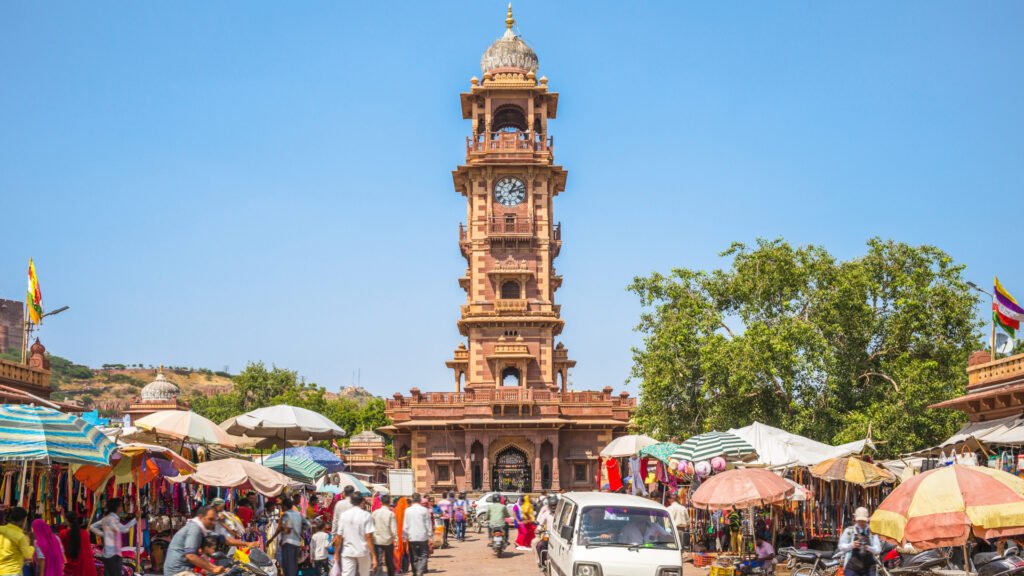
5. Mandore Garden
Mandore Gardens, holds historical significance as the former capital of the Marwar region and the Rathore dynasty. The garden features royal cenotaphs, dome-shaped structures honoring Jodhpur’s rulers, adorned with intricate carvings. Additionally, visitors can explore a museum, temple, zoo, and a hall of heroes, showcasing statues and paintings of local folk legends. Mandore Gardens offers a delightful blend of nature, culture, and history in Jodhpur. Mandore Garden in Jodhpur offers free entry from 8:00 AM to 8:00 PM daily.
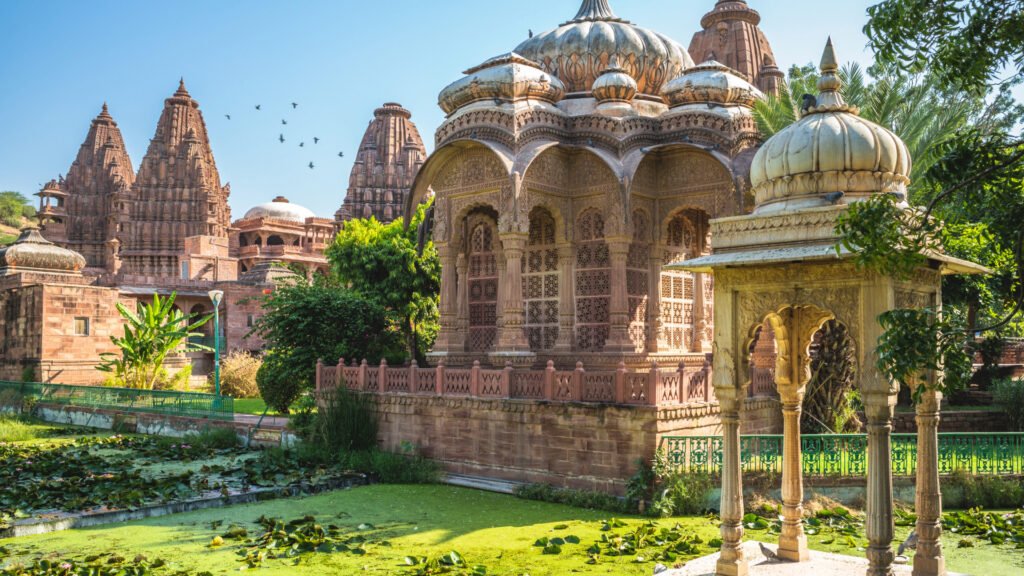
6. Toorji Ka Jhalra (Toorji’s Step Well)
Toorji Ka Jhalra, also known as Toorji’s Step Well, is a historic stepwell in Jodhpur, built in the 18th century by Maharani Toorji. Constructed with red sandstone and featuring seven stories of intricate carvings, the stepwell served as a source of freshwater and a cooling retreat in the desert. A testament to the royal tradition of public waterworks, it stands as a popular tourist attraction, highlighting the art and architecture of the Marwar region.
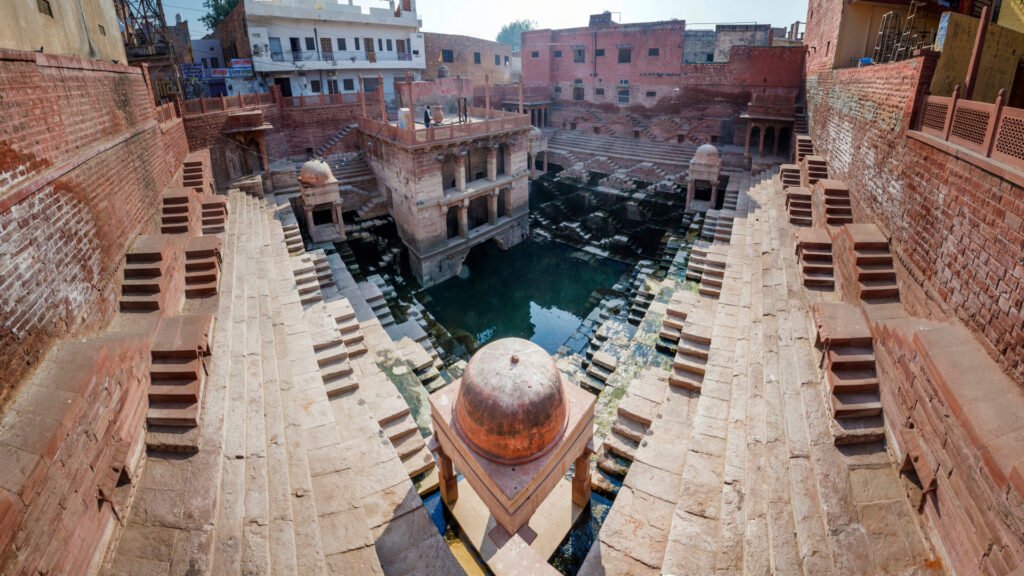
7. The Singaria Coin Museum & Numismatic Research Center India
The Singaria Coin Museum & Numismatic Research Center is a unique institution dedicated to the study and exhibition of coins. With a focus on numismatics, the museum showcases a diverse collection of coins, providing insights into the historical, cultural, and economic aspects of different eras. Visitors can explore the fascinating world of currency, understanding its evolution over time and its role in shaping the rich heritage of India. The museum serves as an educational hub for coin enthusiasts, historians, and researchers alike. welcomes visitors from 8:00 AM to 4:00 PM daily, with an entry fee of INR 50 per person.

8. Rao Jodha Desert Rock Park
Rao Jodha Desert Rock Park is a unique ecological reserve that spans over 70 hectares. Established in 2006, the park is dedicated to the restoration of the rocky terrain surrounding Mehrangarh Fort. It showcases the arid landscape’s indigenous flora, including a variety of desert-adapted plant species. Visitors can explore walking trails, encountering rugged terrain and breathtaking views of Mehrangarh Fort. The park serves as a harmonious blend of environmental conservation and cultural heritage, offering a peaceful retreat for nature enthusiasts and those seeking to experience the natural beauty of the Thar Desert. The Rao Jodha Desert Rock Park is open daily with varying hours according to seasons. The entry fee is INR 100 for adults, INR 200 for a guided walk, and free for school students. The recommended visit duration is 1-2 hours.
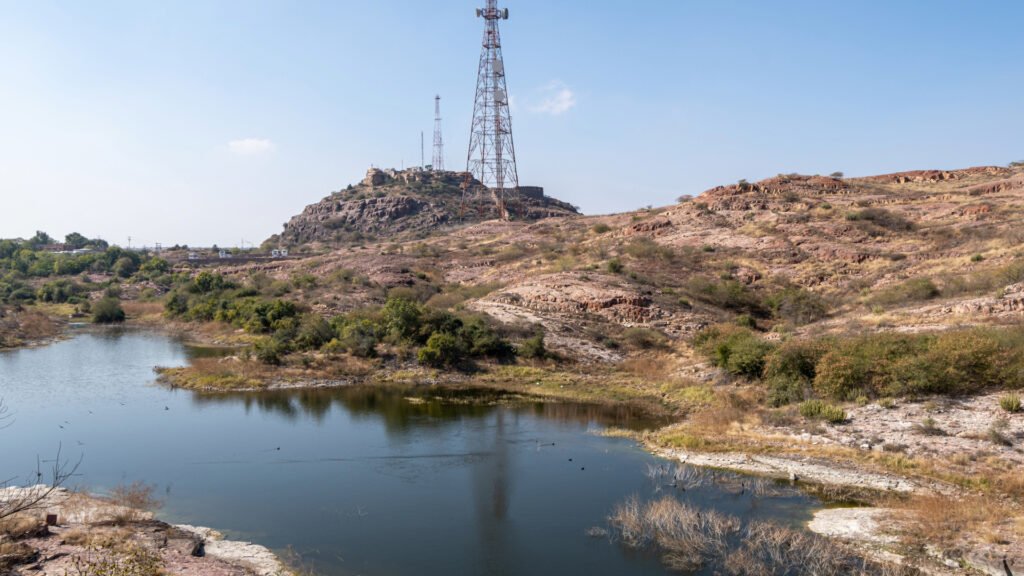
9. Umaid Bhawan Palace Museum
Umaid Bhawan Palace Museum is a part of the Umaid Bhawan Palace, one of the world’s largest private residences and a stunning example of Indo-Saracenic architecture. The museum displays a collection of items that belonged to the former Jodhpur royal family, such as weapons, antiques, crockery, trophies, and stuffed leopards. The museum also exhibits a banner presented by Queen Victoria and a variety of clocks. The museum is open from 10:00 AM to 4:30 PM every day, except for public holidays, and the entry fee is INR 30 for Indians, INR 100 for foreigners, and INR 10 for children. The museum is a great place to learn about the history and culture of Jodhpur and admire the beauty and grandeur of the palace.

10. Phool Mahal
Phool Mahal, located within Mehrangarh Fort in Jodhpur, is a splendid chamber known for its intricate architecture and ornate design. Built during the reign of Maharaja Abhaya Singh, it served as a private and luxurious chamber for entertainment and celebrations. The Phool Mahal, adorned with intricate gold leaf and mirror work, reflects the grandeur and extravagance of the Marwar rulers. It stands as a testament to the rich cultural heritage of Jodhpur. The Phool Mahal welcomes visitors with an entry fee of INR 20 for Indians and INR 250 for foreigners. Open from 9:00 AM to 5:00 PM every day, except Fridays and public holidays, this palace offers a glimpse into the rich heritage of the region.

11. Shri Ganesh Temple
Shri Ganesh Temple is a revered and renowned temple dedicated to Lord Ganesha, the deity of wisdom and success. Located atop the Ratnada hills, approximately 5 km from the city center, the temple houses a large idol of Ganesha, believed to have emerged naturally in the 15th century. With an 8 feet tall and 5 feet wide idol adorned with ornaments, vermilion, and a scenic view of Jodhpur, the temple attracts devotees, especially on auspicious Wednesdays. Offering a spiritual and cultural experience, Shri Ganesh Temple is a must-visit destination in Jodhpur.

12. Arna Jharna : The Thar Desert Museum of Rajasthan
Arna Jharna: The Thar Desert Museum is a cultural institution situated near Jodhpur, specifically in Moklawas village. Established in 2000 by Rupayan Sansthan, led by renowned folklorist Komal Kothari, the museum is dedicated to showcasing the indigenous knowledge systems of the Thar desert. It features exhibits portraying the region’s ecology, intangible heritage, and cultural practices, including folk musical instruments, brooms, pottery, and currencies. The museum offers interactive learning experiences, open-air music performances, and guided walks, providing visitors with insights into the rich folk culture of Rajasthan. Arna Jharna stands as a unique celebration of creativity and diversity in the region’s cultural heritage. The timings of the museum are from 6:00 AM to 6:00 PM on all days of the week, entry free.

13. Chamunda Mata Temple
Chamunda Mata Temple is a revered Hindu shrine dedicated to Goddess Chamunda, a fierce manifestation of Devi. Rao Jodha, the founder of Jodhpur, constructed the Chamunda Mata Temple in 1460. Located atop the picturesque Mehrangarh Fort, the temple offers panoramic views of the city. Devotees climb a series of steps to reach the temple, where they can seek blessings and marvel at the intricate architecture. The temple holds cultural and religious significance, attracting both pilgrims and tourists for a spiritual experience amidst the historical backdrop of Mehrangarh Fort.

14. Santoshi Mata Temple
Santoshi Mata Temple is a sacred place for devotees seeking blessings and solace, it also holds significance in the cultural and religious fabric of Jodhpur. Pilgrims often offer prayers and perform rituals to express their devotion to Goddess Santoshi, especially on Fridays, which is considered an auspicious day for worship. The temple’s architecture and surroundings contribute to the overall spiritual experience, making it a notable site for those exploring the religious heritage of Jodhpur.

15. Kunj Bihari Temple
Kunj Bihari Temple is a revered Hindu temple, dedicated to Lord Krishna, often affectionately called Kunj Bihari. Located in the heart of the city, the temple is a place of spiritual solace and devotion for locals and visitors alike. Devotees frequent the temple to offer prayers, participate in religious ceremonies, and seek the blessings of Lord Krishna. The temple’s architectural charm and religious ambiance make it a peaceful retreat for those seeking a connection with divinity in the vibrant city of Jodhpur.

16. Loha Pol
Loha Pol is the iron gate that serves as the fourth and main entrance to the Mehrangarh Fort in Jodhpur. It is the strongest gate of the fort and has sharp metal spikes to prevent enemy elephants from breaking it down. Inside the gate, there are handprints of the widows of Maharaja Man Singh, who committed self-immolation on his funeral pyre in 1843. Loha Pol is a historic site that attracts many tourists and visitors. Loha Pol is not the only place in India where you can see the handprints of the royal widows. Another famous example is the Chhatri of Maharaja Jaswant Singh II in Jodhpur, where 64 of his consorts and 8 of his slave girls immolated themselves in 1896.

17. Rao Jodha Ji Statue
The Rao Jodha Ji Statue is a tribute to Rao Jodha, the founder of Jodhpur and ruler of Mandore. Perched on a hill near Mehrangarh Fort and Jaswant Thada, the statue depicts Rao Jodha on horseback, pointing towards the fort. Erected in 2009 by the Mehrangarh Museum Trust, the 9-foot tall bronze statue provides a panoramic view of the city. Rao Jodha’s visionary leadership and the statue’s strategic location make it a captivating site for visitors.
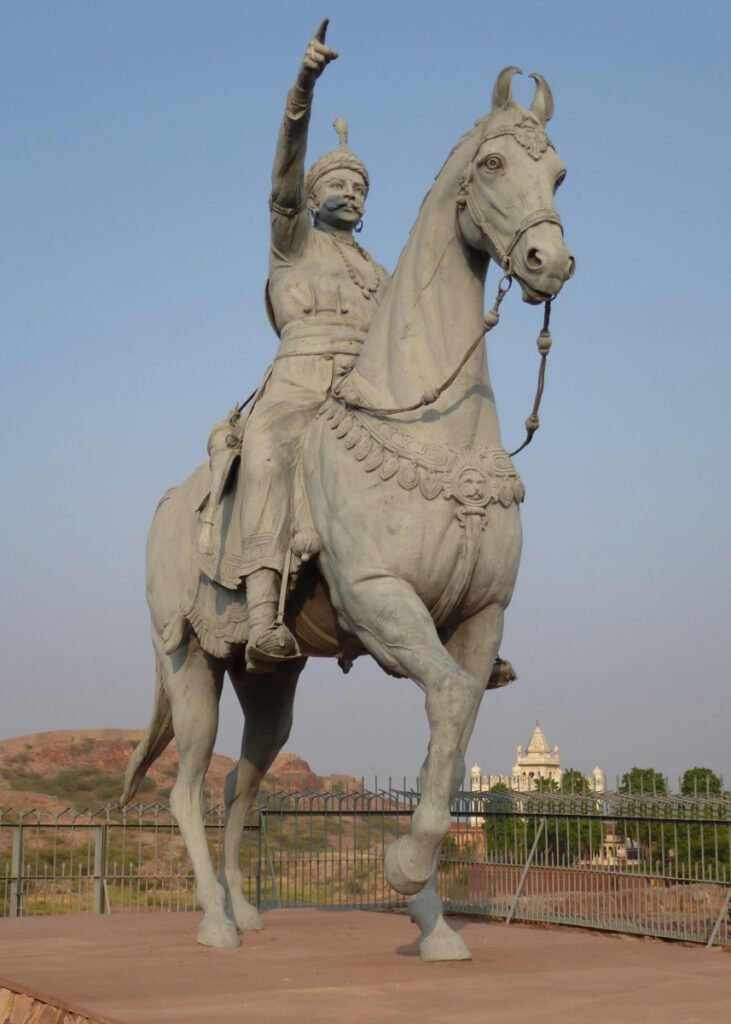
18. Jai Pol
Jai Pol is the name of the main entrance gate of Mehrangarh Fort. Jai Pol means ‘gate of victory’ and it was built by Maharaja Man Singh in 1806 to celebrate his victory over the rival kingdoms of Jaipur and Bikaner. You can see the marks of cannon balls on the walls near the gate, which are reminders of the battles fought here. Jai Pol is one of the seven gates of the fort, which also houses a museum, palaces, temples, and gardens. If you want to visit Jai Pol, you can reach it by bus, taxi, or autorickshaw from the city center. It is open from 9:00 AM to 5:00 PM every day.

19. Kaylana Lake
Kaylana Lake is an artificial lake in Jodhpur, that was built by Pratap Singh in 1872. It covers an area of 0.84 km2 and provides drinking water to the city and nearby villages. It is also a popular spot for nature lovers, bird watchers, and boating enthusiasts. You can enjoy the scenic views of the lake and the surrounding hills, as well as visit the nearby attractions like Machiya Fort and Shiv Mandir. Kaylana Lake is open to visitors at any time of the day, but the best time to visit is from October to March, when the weather is pleasant and the migratory birds arrive.
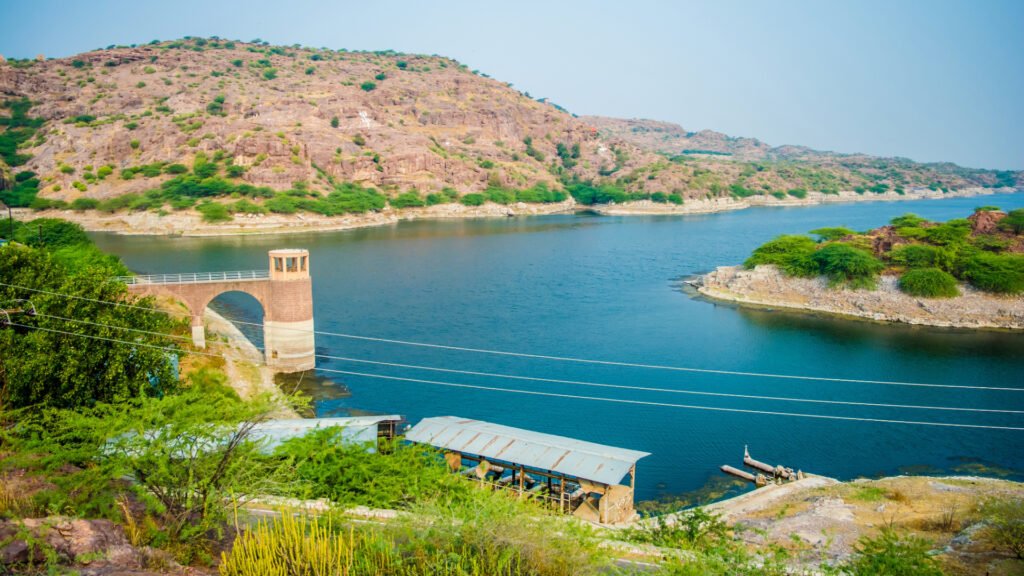
20. Machia Biological Park
Machia Biological Park is a zoological haven nestled in the Machia forest block near Kaylana Lake. Home to diverse wildlife and arid flora, the park includes a nature interpretation center, a veterinary hospital, and a birdwatching point. Additionally, the park features Machia Fort, offering breathtaking views of the lake and city. It hosts a variety of animals, from deer and desert foxes to royal Bengal tigers, making it a paradise for wildlife enthusiasts. The park’s avian diversity, including peacocks, parrots, ducks, and flamingos, further adds to its charm. Open from 8:00 AM to 6:00 PM in summer and 8:30 AM to 5:00 PM in winter (closed on Tuesdays), the entry fee ranges from INR 30 for Indians to INR 300 for foreign nationals, with free entry for children under 5.

21. Sardar Samand Lake
Sardar Samand Lake, located near Jodhpur, is a serene and picturesque artificial reservoir surrounded by hills and lush greenery. Built in 1933 by Maharaja Umaid Singh, the lake serves as a water reservoir and a retreat for migratory birds. The Sardar Samand Palace, overlooking the lake, was originally constructed as a hunting lodge and is now a heritage hotel. Visitors can enjoy the tranquil ambiance, go for boat rides, and witness a variety of bird species, making it an ideal destination for nature lovers and those seeking a peaceful getaway.

22. Chokelao Bagh
Chokelao Bagh is a historic garden that reflects the grandeur of the Marwar region. Built in the 18th century by Maharaja Abhay Singh’s chief architect, Chokelao, the garden boasts intricately designed pavilions, fountains, and lush greenery. It offers panoramic views of the Mehrangarh Fort and the cityscape. With its charming ambiance and architectural elegance, Chokelao Bagh provides a peaceful retreat for visitors to relax, stroll, and appreciate the cultural heritage of Jodhpur. Chokelao Bagh welcomes visitors with an entry fee of INR 30 for Indians and INR 100 for foreigners. The garden is accessible from 9:00 AM to 5:00 PM every day, except Fridays and public holidays, making it an ideal one-hour exploration destination.

23. Sardar Government Museum
Sardar Government Museum is a treasure trove of historical artifacts and cultural exhibits. Established in 1909, the museum showcases a diverse collection, including ancient sculptures, manuscripts, coins, textiles, and weaponry, offering insights into the rich history of the Marwar region. The museum’s architecture itself is a blend of Mughal and Rajput styles. Visitors can explore the various galleries, gaining a deeper understanding of Jodhpur’s heritage and the cultural evolution of Rajasthan over the centuries. The Sardar Government Museum is open daily from 10:00 AM to 5:00 PM, excluding Fridays and public holidays. Admission fees vary for Indians, students, and foreign nationals, with free entry for children under the age of 5.

24. Mahamandir
Mahamandir is a sacred temple dedicated to Lord Shiva, commissioned by Maharaja Shiv Singh in 1812. Noteworthy for its architectural splendor, the temple is supported by 84 intricately carved pillars featuring exquisite designs and motifs. Additionally, Mahamandir includes a yoga hall and a spacious courtyard for religious ceremonies, making it a significant pilgrimage site for Shiva devotees. Positioned approximately 2 km from the city center on the route to Mandore, the temple welcomes visitors daily, except on Fridays and public holidays, from 5:00 AM to 12:00 PM and 4:00 PM to 9:00 PM. The Maha Shivaratri festival, celebrated in February or March, attracts a bustling crowd to this revered location.

25. Ranisar Padamsar Lakes
Ranisar and Padamsar Lakes are twin artificial lakes constructed in 1459 AD. Commissioned by Queen Jasmade Hadi, these lakes served as crucial water reservoirs for the city. Ranisar, the larger of the two, is named after Queen Jasmade, while Padamsar is named after Maharaja Sardar Singh. Surrounded by lush gardens and adorned with cenotaphs and chhatris, these lakes provide a picturesque setting and are popular spots for birdwatching and relaxation. The intricate architecture and historical significance make Ranisar Padamsar Lakes a charming attraction in the Blue City.
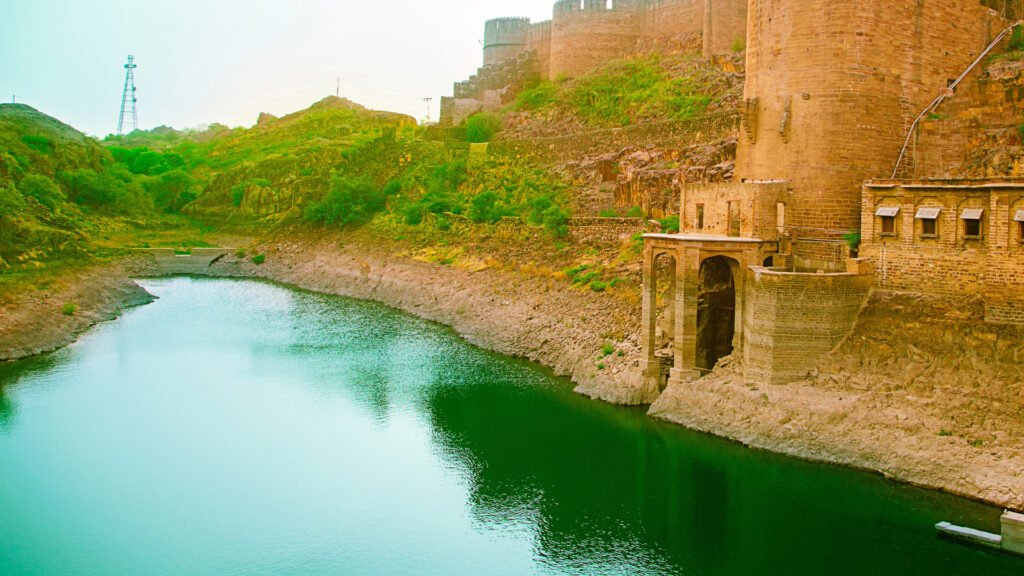
26. Baba Ramdev Temple
Baba Ramdev Temple is a revered shrine dedicated to the local deity Baba Ramdevji, believed to be an incarnation of Lord Krishna’s brother Balarama. This temple holds great significance among the locals, and devotees flock to seek the blessings of Baba Ramdev. Known for its spiritual ambiance, the temple features colorful frescoes and carvings depicting scenes from Hindu mythology. The religious fervor, cultural richness, and peaceful surroundings make Baba Ramdev Temple a sacred and tranquil destination in Jodhpur.
27. Nagnechi Mata Temple
Nagnechi Mata Temple is a revered Hindu shrine dedicated to Goddess Nagnechi, considered a manifestation of Maa Durga. Devotees visit this temple to seek the blessings of the goddess for protection and well-being. The temple’s architecture reflects the cultural and religious significance of the region, with intricate carvings and vibrant decorations adorning the sacred space. The serene ambiance and spiritual aura make Nagnechi Mata Temple a place of devotion and contemplation in Jodhpur.

28. Masuriya Hill Garden
Masuriya Hill Garden is a zoological garden located on the western side of Jodhpur. It is also known as Veer Durgadas Garden, as it houses a statue of Veer Durgadas, a famous warrior of Jodhpur. The garden offers a panoramic view of the city and the Mehrangarh Fort. It has various attractions such as a mini-zoo, a library, a children’s play area, and a cafe. It is a popular spot for birdwatching, as it attracts many migratory and resident birds. The garden is open from 7:00 AM to 9:00 PM on all days except Tuesdays. The entry fee is INR 30 for Indians, INR 300 for foreign nationals, and free for children below the age of 5.

29. Mahila Bagh Zhalra
Mahila Bagh Zhalra is a subterranean stepwell that was built in the 18th century by a wealthy concubine named Mayla. It is located near the Mehrangarh Fort and has pyramidal stairs that lead to the water level. It is a hidden treasure that showcases the history and culture of Jodhpur. The entry fee to visit Mahila Bagh Zhalra is INR 30 per person for Indians and INR 100 per person for foreigners. The stepwell is open from 11:00 AM to 10:30 PM on all days except Fridays and public holidays.

30. Jambaji Temple
Jambaji Temple is a Hindu temple dedicated to Jambeshwar Bhagwan, the founder of the Bishnoi sect, located in the village of Jamba in Jodhpur district. Serving as a pilgrimage site for the Bishnois, the temple emphasizes the 29 principles of Jambeshwar Bhagwan, focusing on non-violence, environmental protection, and social justice. Renowned for its architecture and sculptures illustrating the life and teachings of Jambeshwar Bhagwan, the temple welcomes visitors from 6:00 AM to 8:00 PM every day.
31. Achal Nath Shivalaya
Achal Nath Shivalaya is a revered Shiva temple constructed in 1531 by Queen Nanak Devi, wife of Rao Ganga. The temple features a Shivlinga near the Ganga Bawari water reservoir and boasts three intricately carved halls made of Chhitar stones. Open from 10:00 AM to 4:30 PM every day, except Fridays and public holidays, the temple charges an entry fee of INR 30 for Indians and INR 300 for foreigners. It stands as a significant spiritual and architectural landmark in the city.

32. Ashapura Mata Mandir
Ashapura Mata Mandir is a revered temple dedicated to Goddess Ashapura, a form of Mata Parvati. Devotees flock to this sacred site to seek the blessings of the deity. The temple premises exude a spiritual atmosphere, and the idol of Goddess Ashapura is adorned with traditional ornaments. Open to visitors, the temple hosts regular worship ceremonies, attracting both locals and tourists seeking a divine experience. The Ashapura Mata Mandir is a significant religious destination in Jodhpur, reflecting the cultural and spiritual richness of the region.

33. Chopasni Mandir
Chopasni Mandir, also known as Shyam Manohar Prabhu Badi Haveli Chaupasani Mandir, is a historic Hindu temple dedicated to Lord Krishna. Situated approximately 10-12 km from the city center, the temple holds significant religious importance for Krishna devotees. Characterized by its old and magnificent haveli-style architecture, the temple, while not extensively maintained, is renowned for its sincere and devoted service to Lord Krishna.

34. Flying Fox Jodhpur
Flying Fox Jodhpur offers an exhilarating zip-lining experience in the scenic landscape of Jodhpur. Adventurers can soar through the air on a series of zip lines, enjoying breathtaking views of the Mehrangarh Fort, the blue city, and the surrounding desert. The Flying Fox adventure allows participants to glide over the historic landscapes, providing a unique and thrilling perspective of Jodhpur’s beauty and cultural heritage. With professionally designed courses and a focus on safety, Flying Fox Jodhpur offers an exciting outdoor activity for those seeking an adrenaline rush amid the city’s rich historical backdrop. The admission fee for Flying Fox Jodhpur is INR 1899 per adult (rack rate), INR 1650 per adult (online), and INR 1450 per child (online)34. The experience is available from 9:30 AM to 5:00 PM every day, excluding Fridays and public holidays.

35. Sheesh Mahal, Jodhpur
Sheesh Mahal is a mirror-adorned palace within the Mehrangarh Fort complex, constructed by Maharaja Ajit Singh in the 18th century for his bedchamber and entertainment. Adorned with thousands of tiny mirrors that produce a dazzling effect by reflecting light, the palace also boasts walls adorned with paintings depicting religious figures and floral motifs crafted in plaster. A masterpiece of Rajput and Mughal architecture, Sheesh Mahal is a captivating tourist destination. The entry fee for Sheesh Mahal is INR 30 per person for Indians and INR 100 per person for foreigners. The palace is open from 9:00 AM to 5:00 PM on all days except Fridays and public holidays.
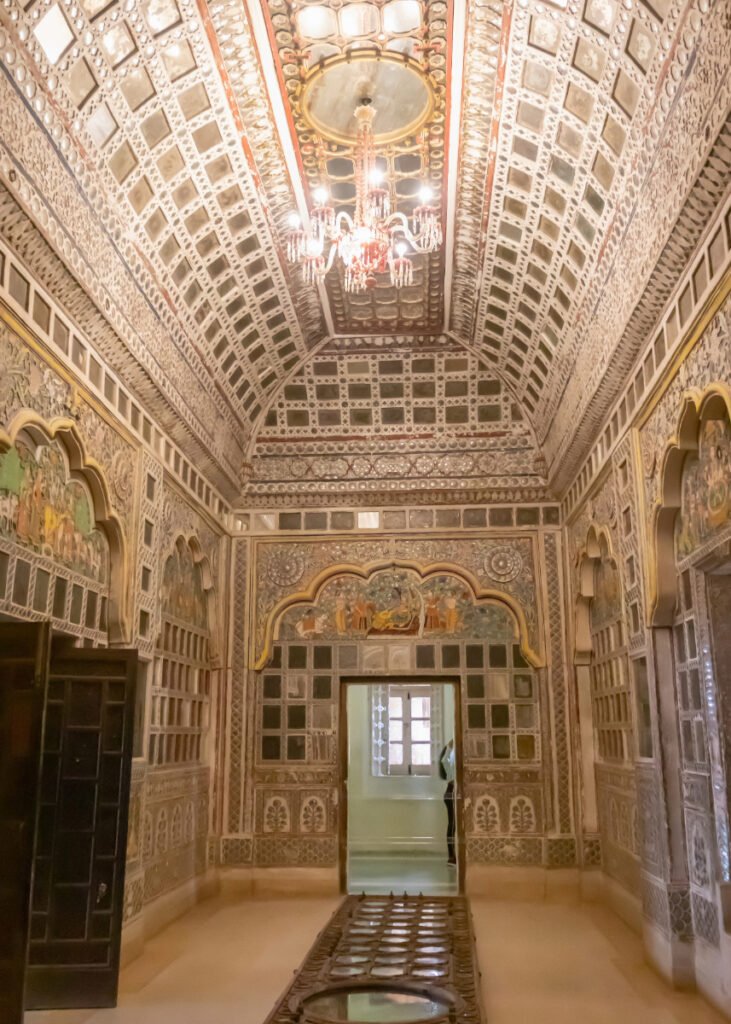
36. Shastri Circle
Shastri Circle, offering a delightful environment for visitors. With a captivating musical fountain show accompanied by lights in the evenings, a dedicated children’s playground, and various nearby eateries, it provides a pleasant recreational experience. Additionally, the area serves as a haven for birdwatching, attracting both migratory and resident birds. Situated on Shastri Nagar Road, near Saint Paul’s Senior Secondary School, Shastri Circle is a popular destination for both locals and tourists alike.

37. Umed Garden Zoo
Umed Garden Zoo was inaugurated by Viceroy Willingdon during the British Raj and is part of the Umed Garden, named after Maharaja Umed Singh. This zoological garden is home to various wild animals like tigers, lions, zebras, ostriches, emus, crocodiles, and leopards. Additionally, it features a walk-in aviary showcasing diverse bird species, both migratory and resident. The zoo is open from 10:00 AM to 4:30 PM every day except Fridays and public holidays, with an entry fee of INR 3 for Indians and INR 10 for foreigners.

38. Gulab Sagar lake
Gulab Sagar Lake is a picturesque artificial reservoir that adds to the city’s charm. Built in the mid-18th century, it was initially intended to provide a water source for the residents. The lake is surrounded by historic structures and heritage buildings, creating a serene and scenic atmosphere. Visitors can enjoy a peaceful stroll along its shores or capture the reflections of surrounding architecture in its calm waters. Gulab Sagar Lake stands as a testament to Jodhpur’s architectural and historical legacy.
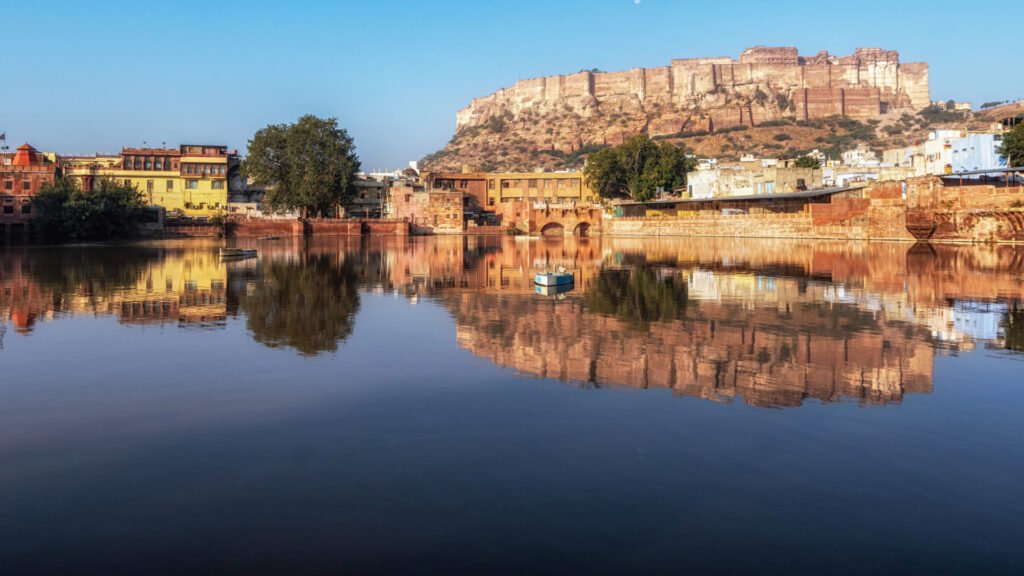
These weremsome places to visit in Jodhpur. Hope you liked it. Have a safe journey!
How To Reach Jodhpur From Delhi
- By Air:
- The nearest airport to Jodhpur is Jodhpur Airport (JDH). You can take a direct flight from Indira Gandhi International Airport (DEL) in Delhi to Jodhpur. The flight duration is approximately 2 hours.
- By Train:
- Jodhpur is well-connected by trains from Delhi. There are several daily trains between New Delhi Railway Station (NDLS) and Jodhpur Junction (JU). The train journey takes around 10 to 12 hours, depending on the train.
Here is a list of trains from Delhi to Jodhpur, including their name, number, departure station, departure time, arrival station, arrival time, duration, distance, and fare for the general quota and sleeper class:
| Train Name | Train Number | Departure Station | Departure Time | Arrival Station | Arrival Time | Duration | Distance | Fare |
|---|---|---|---|---|---|---|---|---|
| Mandore Express | 22995 | Old Delhi | 21:20 | Jodhpur Jn | 07:30 | 10 H 10 M | 622 km | INR 270 |
| Delhi Sarai Rohilla – Jodhpur SF Express | 22482 | Delhi S Rohilla | 23:10 | Jodhpur Jn | 09:35 | 10 H 25 M | 616 km | INR 270 |
| Salasar SF Express | 22421 | Delhi S Rohilla | 07:05 | Jodhpur Jn | 17:50 | 10 H 45 M | 616 km | INR 270 |
| Jammu Tawi – Barmer Express | 14662 | Old Delhi | 11:00 | Jodhpur Jn | 22:45 | 11 H 45 M | 622 km | INR 270 |
| Corbett Park Link Express | 25014 | Old Delhi | 04:30 | Jodhpur Jn | 16:35 | 12 H 5 M | 622 km | INR 270 |
| Ranikhet Express | 15014 | Old Delhi | 04:30 | Jodhpur Jn | 16:35 | 12 H 5 M | 622 km | INR 270 |
| Runicha Express | 14087 | Old Delhi | 08:55 | Jodhpur Jn | 21:00 | 12 H 5 M | 622 km | INR 270 |
These trains running status may vary according to trains schedule, timing & availability. For accurate details you can visit official website of railway – IRCTC
For the most up-to-date information on availability, timings, and fares, you can check these details on various websites online.
- By Road:
- You can also travel to Jodhpur by road. The distance between Delhi and Jodhpur is approximately 600 kilometers, and you can either drive or take a bus. The journey by road takes approximately 10 to 12 hours, depending on the mode of transportation and traffic conditions.
- By Bus:
- There are regular bus services from Delhi to Jodhpur. You can choose between government-operated buses and private buses. The bus journey takes around 11 to 12 hours.
- By Car:
- You can opt to drive from Delhi to Jodhpur, which gives you the flexibility to stop at places of interest along the way. The journey by car takes around 10 to 12 hours, depending on the route and traffic.
Best Time To Visit in Jodhpur
The best time to visit Jodhpur is from October to March when the weather is pleasant, ranging from 10°C to 25°C. This period allows for comfortable exploration of the city’s attractions like Mehrangarh Fort and Umaid Bhawan Palace. Festivals like Diwali and Navratri add cultural vibrancy. It’s advisable to avoid the hot summer months (April to September) when temperatures exceed 40°C and considerate planning is needed during the monsoon season (July to September) due to heavy rainfall.
Nearest Places To Jodhpur
| City | Distance from Jodhpur | Major Attractions |
|---|---|---|
| Khimsar | 98 km | Khimsar Fort, Khimsar Dunes Village, Dhawa Doli Wildlife Sanctuary1 |
| Nagaur | 141 km | Nagaur Fort, Akbari Mahal, Tarkeen Dargah2 |
| Khichan | 153 km | Khichan Bird Sanctuary, Demoiselle Cranes3 |
| Ajmer | 198 km | Ajmer Sharif Dargah, Ana Sagar Lake, Taragarh Fort4 |
| Pushkar | 216 km | Brahma Temple, Pushkar Lake, Pushkar Camel Fair |
